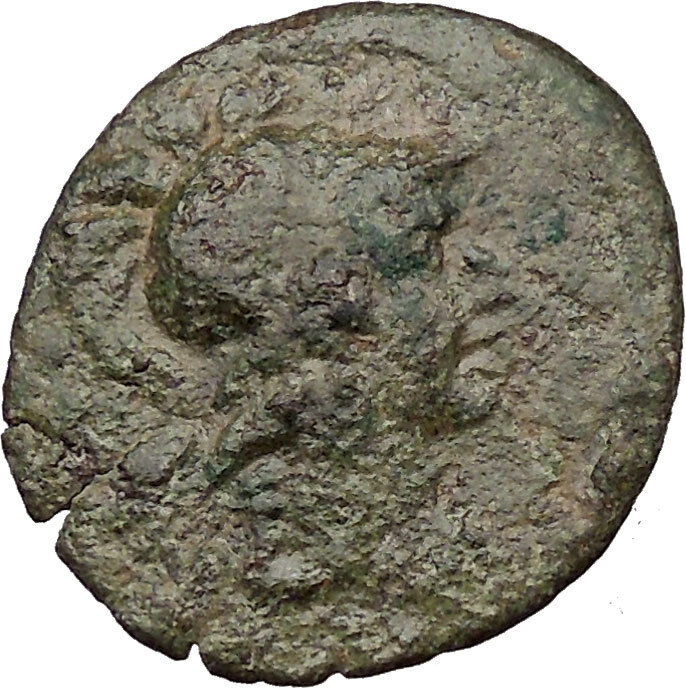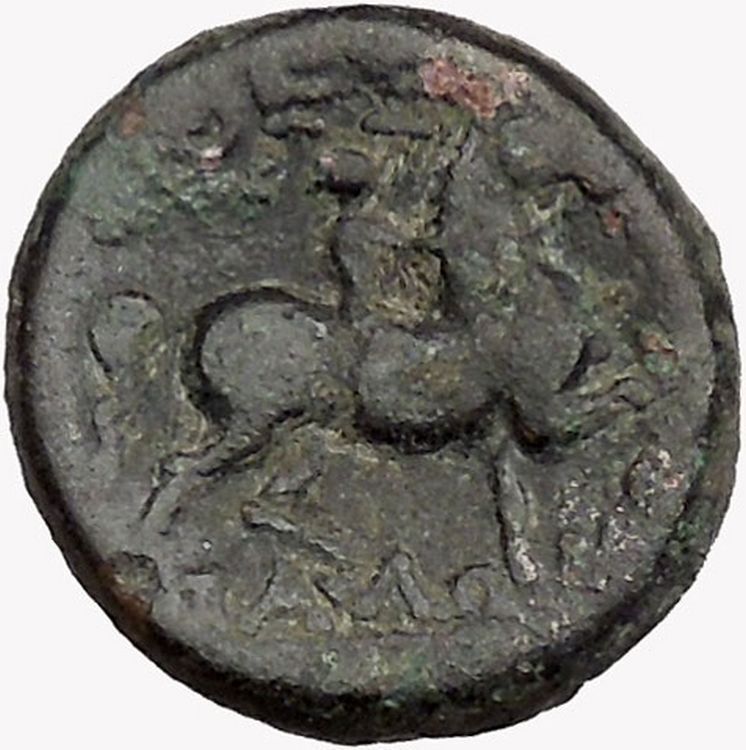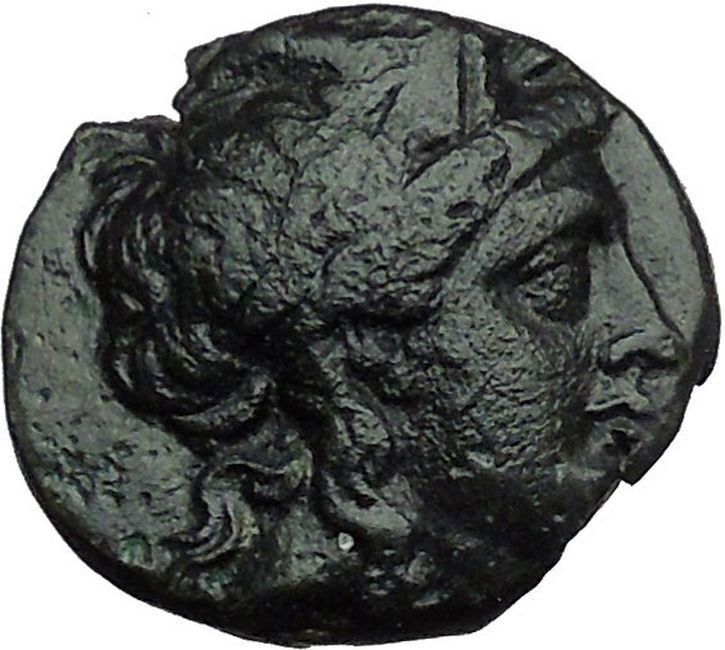|
Greek city of
Larissa in
Thessaly
Bronze 20mm (6.03 grams) Struck 350-325 B.C.
Reference: Sear 2132; Rogers 1932, nos. 284-287; BCD
Thessaly I, lot 1171.1; BCD Thessaly I, lot 393
Head of nymph Larissa three-quarter face to left,
wearing necklace; hair confined by fillet
and floating loosely, with ampyx in front.
ΛΑΡΙΣΑIΩN, Thessalian
horseman right, holding spear, horse prancing.
This city was named after a local
water nymph named Larissa. The story goes that the nymph
drowned while playing ball on the banks of the Peneios
River. In Greek mythology, the Greek hero Perseus
accidentally killed his grandfather, King Akrisios of
Argos when participating in the funeral games held in
the city for nymph Larissa. The people of that city made
their wealth from the rich agricultural area around the
city and from breeding horses.
You
are bidding on the exact item pictured, provided with a
Certificate of Authenticity and Lifetime Guarantee of
Authenticity.

In this 1896 painting by
John William Waterhouse
,
Hylas
is abducted by the
Naiads
, i.e. fresh water nymphs

Echo,
an Oread
(mountain nymph) watches
Narcissus
in this 1903 painting by
John William Waterhouse
.
|

A nymph (Greek:
νύμφη, nymphē) in
Greek mythology
and in
Latin mythology
is a minor female nature deity
typically associated with a particular location or landform. Different from
goddesses, nymphs are generally regarded as divine spirits who animate nature,
and are usually depicted as beautiful, young
nubile
maidens who love to dance and sing;
their amorous freedom sets them apart from the restricted and chaste wives and
daughters of the Greek
polis
. They are believed to dwell in
mountains and
groves
, by springs and rivers, and also in
trees and in valleys and cool
grottoes
. Although they would never die of old
age nor illness, and could give birth to fully immortal children if mated to a
god, they themselves were not necessarily immortal, and could be beholden to
death in various forms.
Charybdis
and
Scylla
were once nymphs.
Other nymphs, always in the shape of young maidens, were part of the
retinue
of a god, such as
Dionysus
,
Hermes
, or
Pan
, or a goddess, generally the huntress
Artemis
. Nymphs were the frequent target of
satyrs
.
Etymology
Nymphs are personifications of the creative and fostering activities of
nature, most often identified with the life-giving outflow of springs: as
Walter Burkert
(Burkert 1985:III.3.3) remarks,
“The idea that rivers are gods and springs divine nymphs is deeply rooted not
only in poetry but in belief and ritual; the worship of these deities is limited
only by the fact that they are inseparably identified with a specific locality.”
The
Greek
word
νύμφη has “bride” and “veiled” among its meanings: hence a marriageable
young woman. Other readers refer the word (and also
Latin
nubere and
German
Knospe) to a root expressing the
idea of “swelling” (according to
Hesychius
, one of the meanings of
νύμφη is “rose-bud”).
Adaptations
The Greek nymphs were spirits invariably bound to places, not unlike the
Latin genius loci
, and the difficulty of
transferring their cult may be seen in the complicated myth that brought
Arethusa
to Sicily. In the works of the
Greek-educated
Latin poets
, the nymphs gradually absorbed into
their ranks the indigenous Italian divinities of springs and streams (Juturna,
Egeria
,
Carmentis
,
Fontus
), while the
Lymphae
(originally Lumpae), Italian
water-goddesses, owing to the accidental similarity of their names, could be
identified with the Greek Nymphae. The mythologies of classicizing Roman poets
were unlikely to have affected the rites and cult of individual nymphs venerated
by country people in the springs and clefts of
Latium
. Among the
Roman
literate class, their sphere of influence
was restricted, and they appear almost exclusively as divinities of the watery
element. Nymphs are also portrayed as selfish and as attention seekers who walk
around naked in the middle of forests.
Larissa (Greek:
Λάρισα) is the
capital and largest city of the
Thessaly
region
of
Greece
and capital of
the
Larissa
regional unit.
It is a principal agricultural centre and a national
transportation hub, linked by road and rail with the
port of
Volos
, the city of
Thessaloniki
and
Athens
. Larissa, within
its municipality, has 162,591 inhabitants, while the
regional unit of Larissa reached a population of 284,325
(in 2011). The urban area of the city, although mostly
contained within the Larissa municipality, also includes
the communities of
Giannouli
,
Platykampos
,
Nikaia
, Terpsithea and
several other suburban settlements, bringing the wider
urban area population of the city to about 174,012
inhabitants and extends over an area of 572.3 km2.
Today, Larissa is a major commercial and industrial
centre in
Greece
. Legend has it
that
Achilles
was born here,
and that
Hippocrates
, the Father
of Medicine, died here.

The first ancient theatre of Larissa
Traces of
Paleolithiccc
human
settlement have been recovered from the area, but it was
peripheral to areas of advanced culture. The area around
Larissa was extremely fruitful; it was agriculturally
important and in
antiquity
was known for
its horses.

Mount Ossa
viewed from
Pineios river
in
Larissa.
The name Larissa (Λάρισα Lárīsa) is in origin
a
Pelasgian
(pre-Greek)
word for “fortress”. There were many ancient Greek
cities with this name. The name of Thessalian Larissa is
first recorded in connection with the aristocratic
Aleuadai
family.
Larissa is thought to be where the famous Greek
physician
Hippocrates
and the
famous philosopher
Gorgias of Leontini
died.
When Larissa ceased minting the federal coins it
shared with other Thessalian towns and adopted its own
coinage in the late 5th century BC, it chose local types
for its coins. The obverse depicted the nymph of the
local spring, Larissa, for whom the town was named;
probably the choice was inspired by the famous coins of
Kimon
depicting the
Syracusan nymph
Arethusa
. The reverse
depicted a horse in various poses. The horse was an
appropriate symbol of Thessaly, a land of plains, which
was well known for its horses. Usually there is a male
figure; he should perhaps be seen as the eponymous hero
of the Thessalians, Thessalos, who is probably also to
be identified on many of the earlier, federal coins of
Thessaly.

The
first ancient theatre
of the city.
Larissa, sometimes written Larisa on ancient coins
and inscriptions, is near the site of the Homeric
Argissa. It appears in early times, when
Thessaly
was mainly
governed by a few aristocratic families, as an important
city under the rule of the
Aleuadae
, whose
authority extended over the whole district of
Pelasgiotis
. This
powerful family possessed for many generations before
369 BC the privilege of furnishing the tagus, the
local term for the
strategos
of the
combined Thessalian forces. The principal rivals of the
Aleuadae were the
Scopadac
of
Crannon
, the remains of
which are about 14 miles south west.
Larissa was indeed the birthplace of
Meno
, who thus became,
along with
Xenophon
and a few
others, one of the generals leading several thousands
Greeks from various places, in the ill-fated expedition
of 401 (retold in Xenophon’s
Anabasis
) meant to
help
Cyrus the Younger
, son
of
Darius II
, king of
Persia
, overthrow his
elder brother
Artaxerxes II
and take
over the throne of Persia (Meno is featured in
Plato
‘s dialogue
bearing his name, in which
Socrates
uses the
example of “the way to Larissa” to help explain
Meno the difference between true
opinion
and
science
(Meno, 97a–c) ;
this “way to Larissa” might well be on the part of
Socrates an attempt to call to Meno’s mind a “way home”,
understood as the way toward one’s true and “eternal”
home reached only at death, that each man is supposed to
seek in his life).
The constitution of the town was
democratic
, which
explains why it sided with
Athens
in the
Peloponnesian War
. In
the neighbourhood of Larissa was celebrated a festival
which recalled the Roman
Saturnalia
, and at
which the slaves were waited on by their masters. As the
chief city of ancient Thessaly, Larissa was taken by the
Thebans
and later
directly annexed by
Philip II of Macedon
in
344. It remained under Macedonian control afterwards,
except for a brief period when
Demetrius Poliorcetes
captured it in 302 BC.
It was in Larissa that
Philip V of Macedon
signed in 197 BC a treaty with the Romans after his
defeat at the
Battle of Cynoscephalae
,
and it was there also that
Antiochus III the Great
,
won a great victory in 192 BC. In 196 BC Larissa became
an ally of Rome and was the headquarters of the
Thessalian League
.
Larissa is frequently mentioned in connection with
the
Roman civil wars
which
preceded the establishment of the
Roman Empire
and
Pompey
sought refuge
there after the defeat of
Pharsalus
.
|














